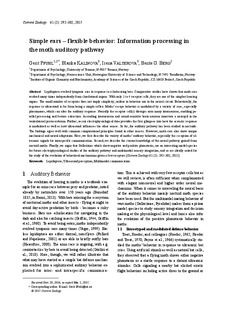Simple ears - flexible behavior: Information processing in the moth auditory pathway
Peer reviewed, Journal article
Permanent lenke
http://hdl.handle.net/11250/2381447Utgivelsesdato
2015Metadata
Vis full innførselSamlinger
- Institutt for psykologi [3143]
- Publikasjoner fra CRIStin - NTNU [38576]
Originalversjon
Current Zoology 2015, 61(2):292-302Sammendrag
Lepidoptera evolved tympanic ears in response to echolocating bats. Comparative studies have shown that moth ears evolved many times independently from chordotonal organs. With only 1 to 4 receptor cells, they are one of the simplest hearing organs. The small number of receptors does not imply simplicity, neither in behavior nor in the neural circuit. Behaviorally, the response to ultrasound is far from being a simple reflex. Moths’ escape behavior is modulated by a variety of cues, especially pheromones, which can alter the auditory response. Neurally the receptor cell(s) diverges onto many interneurons, enabling parallel processing and feature extraction. Ascending interneurons and sound-sensitive brain neurons innervate a neuropil in the ventrolateral protocerebrum. Further, recent electrophysiological data provides the first glimpses into how the acoustic response is modulated as well as how ultrasound influences the other senses. So far, the auditory pathway has been studied in noctuids. The findings agree well with common computational principles found in other insects. However, moth ears also show unique mechanical and neural adaptation. Here, we first describe the variety of moths’ auditory behavior, especially the co-option of ultrasonic signals for intraspecific communication. Second, we describe the current knowledge of the neural pathway gained from noctuid moths. Finally, we argue that Galleriinae which show negative and positive phonotaxis, are an interesting model species for future electrophysiological studies of the auditory pathway and multimodal sensory integration, and so are ideally suited for the study of the evolution of behavioral mechanisms given a few receptors [Current Zoology 61 (2) : 292–302, 2015 ].
Keywords: Lepidoptera, Ultrasound perception, Multimodal communication
